FISHING FOR GOLD – Golden Dorado in Bolivia
Ruhan Neethling

He erupted with sunset on his sides and tail and the ferocity of an attack dog on a very short leash. For a moment I could not imagine taming this wild creature with the flimsy piece of graphite in my hands, but he came to hand and all I could think of was that this was one of the most beautiful living beings I had ever seen.

With the colour of pure gold on its sides, a holographic design on the gill plates, one of the most attractive tails in the piscatorial world and the attitude of a very angry pit bull terrier, the Golden Dorado must rate as one of the most exotic and desirable freshwater fly rod targets in the world – or any water for that matter. Add to this the magic of the Amazon jungle and clear freestone rivers with deep pools, smooth glides and amazing pocket water, and you have the makings of something really special.
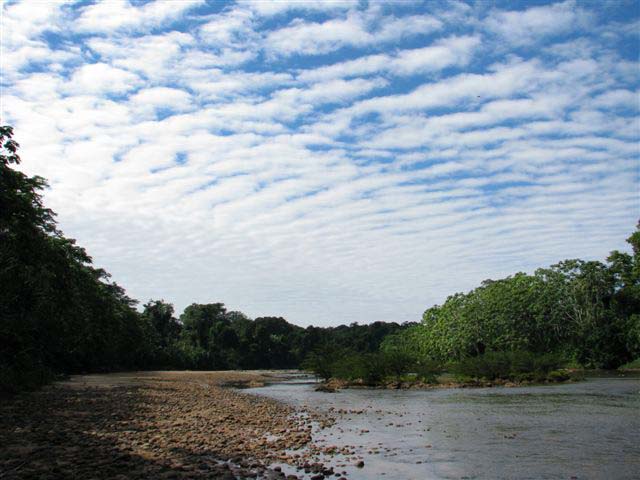
About five months ago I received an invitation to fish for Golden Dorado in Bolivia, where the Amazon meets the Andes. This is a newly discovered fishery for Golden Dorado, and what makes it extraordinarily special, are the rivers. These are clear freestone rivers, much like the beautiful rivers found on New Zealand’s South Island, and a lot of the fishing is sight casting to Dorado. Needless to say it did not require much convincing for me to jump at this opportunity.
I had to travel halfway around the world which involved many flights, airports and customs, until I finally met up with Val in Miami for the final leg to Santa Cruz in Bolivia. There we met up with the rest of the group, Jim and Priscilla (a couple from Hawaii) and Craig (a doctor from Oregon in the US). We were to spend a night in Santa Cruz before boarding a charter flight the next morning to the first of two lodges deep in the jungle. Craig and I were to be fishing partners and already on that first night it became apparent that we both have severe ATNB syndrome (Around the Next Bend) so we decided that we would be sleeping out if possible.
Over dinner we also met with one of the entrepreneurs who had discovered the fishery and he entertained us with stories of their first scouting trips and the big Dorado encountered. This obviously did not benefit my already poor sleeping patterns that night.
The next morning could not arrive soon enough and we finally boarded the single prop Cessna en route to the mountains. It now really felt as if we were on an adventure of a lifetime; this was driven home when we touched down on the smallest little bush strip I have ever landed on (living in Papua New Guinea means I have experienced many!). Here we were greeted by our guides and a horde of inquisitive Amazonian Indians. Our cameras were clicking away and after ever photo we had to show a handful of kids the images, which resulted in many oohs and aahs! A real treat was when Priscilla took out her iPad and put on a TV show for them to watch. We were truly in the jungle and very far away from “civilization“!
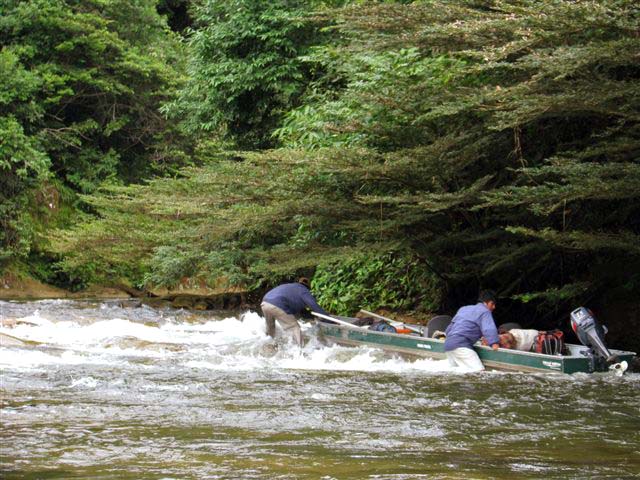
After the “meet and greet” and stretching cramped legs, we were taken by long aluminium boats resembling dug-outs, up river to the lodge. At last we were on the water, not fishing yet, but at least on the water. It took about half an hour to reach the lodge…and the fact that we saw our first Golden Dorado in the first pool above the airstrip had my excitement boiling over.
Golden Dorado in these rivers grow to 40 plus pounds with fish of around the 20 pound mark coming out on a regular basis. They are a very aggressive predatory species and mainly prey on sucker fish called Sabalo. Never in my life have I seen a river with so high a biomass. There are schools of Sabalo everywhere, easily numbering in their hundreds. The Golden Dorado migrate with the Sabalo into the headwaters of this system during May. It is currently believed they actually spawn with the Sabalo so that their fry have Sabalo fry to feed on. Talk about predatory!
During the warmer parts of the day the Dorado hunt in packs and push the Sabalo into the shallows where they then crash into them, rivaling anything you will ever see in the salt. They hunt in such shallow water that their tails actually get worn down like salmons’ do when they are spawning. We targeted them in the shallows when they were hunting, and in the pockets, pools and runs when they were not actively hunting. It is amazing to see a school of five to ten fish (I think “pack” is probably more appropriate-they reminded me of wolves) holding in a pocket 10 meters across; enough to get anyone shaking.
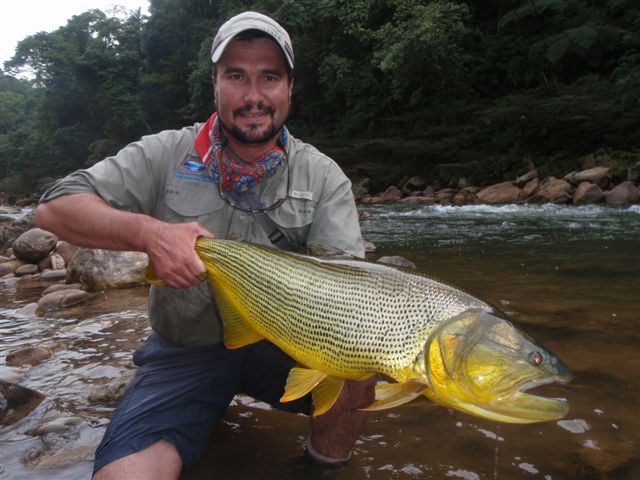
Presentation does not count for much; this is brutal, raw fishing. We were using 8 weight rods with 20 to 30 lb tippets and 30 or 40 lb wire. Oh, yes, I forgot to mention, they have TEETH! We probably averaged about two fish per fly, if that. And the big ones can actually bite through 20lb wire! These fish are fly destroyers, as bad as, if not worse than, the mackerel species and wahoo found in the salt. BIG flies and FAST strips are not only the norm, they are essential, reminding even more of salt water fishing.
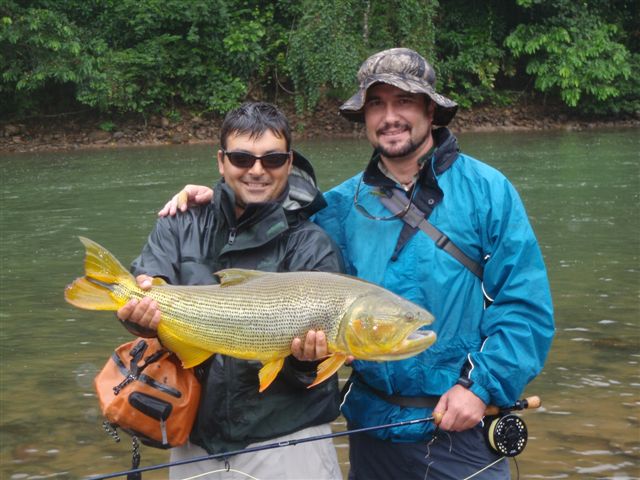
We fished for three days out of the first camp, named Asunta. Craig and I managed a sleep-out and fished higher up than has been fished this season to date. We got some excellent fish; Craig also managed to catch a Pacu of 17 lbs (a member of the piranha family, but luckily mostly vegetarian). Dinner was a couple of Sabalo speared by the native Indians with bow and arrow, cooked on sticks over the fire, Indian style. One of the best fish meals I have ever enjoyed!
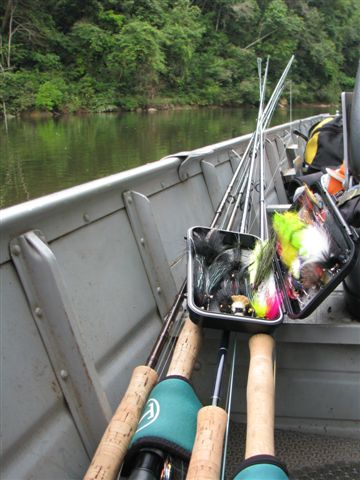
On day four we were flown to a second camp, Pluma for three and half more days fishing. Here Craig, Val and I had an amazing day upstream on the Itirizama River. In the first run, we spotted a pack of good sized fish herding and crashing through Sabalo in very shallow water with their backs halfway exposed. I was “on strike” and made a very frantic cast into the middle of this mess. One strip and the line went flying from my hand as a train connected to my fly and took to the tracks. A beautiful 10 pounder came to hand and in the beautiful morning sunlight he looked fake, like something sculpted out of gold by a very good craftsman. This promised to be a top day.
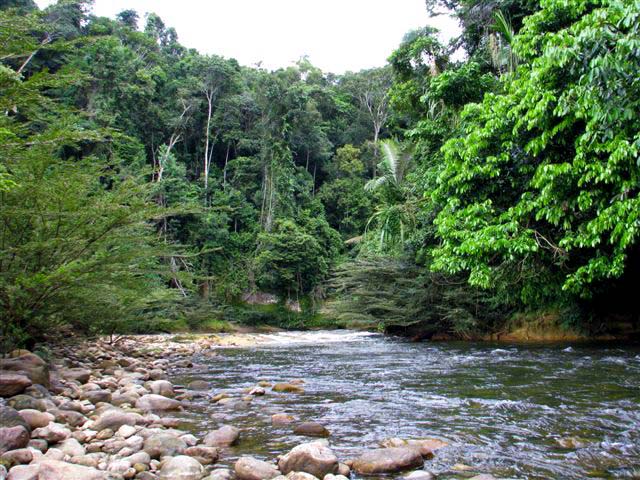
Higher up in the river we came to a stretch where we caught 10 lb fish after fish in some of the prettiest pocket water I have ever seen. Almost every pocket was lined with Gold and we could do almost nothing to keep them off our lines. In this stretch Val had an epic battle with a good fish that took him through some serious pocket water in a big pool below. He had to really do all he could to keep up with it and swears he should have lost it a number of times.
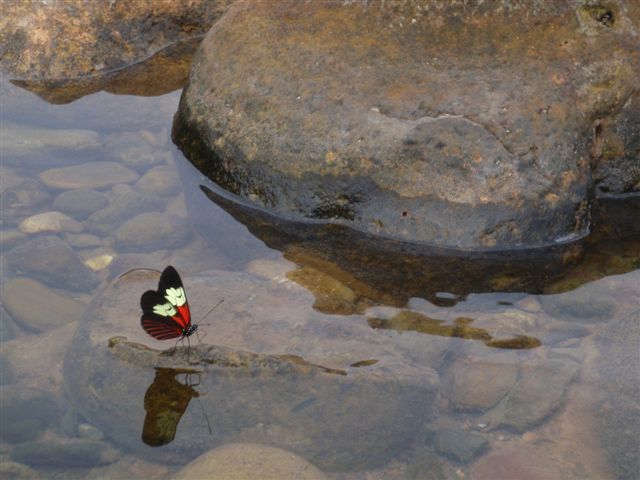
One memorable afternoon, just below the Pluma camp on a big pool, I got smoked so badly by a good fish that I actually jumped into the current, feet off the bottom, to try and save what I could, unfortunately to no avail.

Add to this image the prettiest, most prolific butterflies I have ever seen, the 20 pounder that ate my fly at my feet in some serious white water, the last fish for the trip, which actually was a “three chance fish”, or the….I am sure you get the picture. I have too many mind-pictures from this trip to put into a single article, so will just quit here.
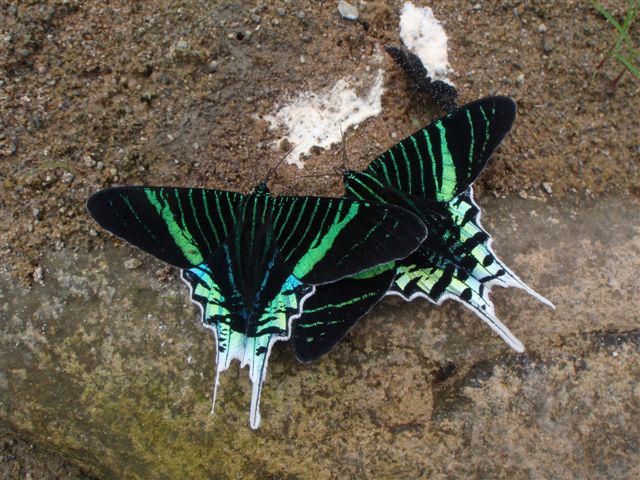
Was it worth traveling through four countries and enduring numerous flights? You bet!…It is wilder than you can dream about, with amazing scenery around every bend (and there are many) and enough luxury at the lodges to keep even the fussiest aficionado happy. Oh, and did I mention the Golden Dorado is truly something out of this world.
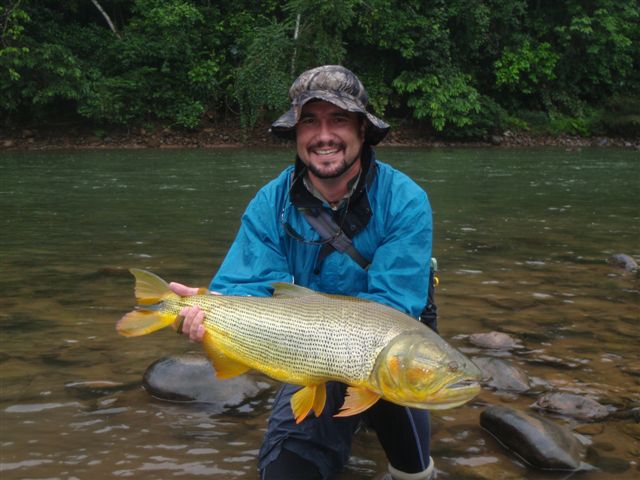
FACT BOX:
How to get there: AA flies to Santa Cruz (Bolivia) twice a week via La Paz. From Santa Cruz you fly with a charter organised by the operator to the two lodges and back again to Santa Cruz. On the return leg you catch the direct flight back from Santa Cruz to Miami.
What to take: The normal fishing stuff (you know, hat, sun block, clothes, etc). For actual fishing gear I used an 8 weight, a 9 foot leader down to 20lb tippet and then wire. Take enough, I went through 2 and a bit spools as you have to change flies after almost every fish. On the sharp end, I found dark flies with a bit of flash in the 3 to 5 inch range worked best, especially those with bunny strip tails. As you will be doing a lot of sight fishing, good polarized sunnies are a must. And take bug spray. The noseeums there are ferocious.
Cost: The trip cost $6,000 (will likely increase next season). This includes everything in Bolivia except first and last meals in Santa Cruz, tackle and tips. To this you have to add cost of flights to Santa Cruz. For me that was from Papua New Guinea!
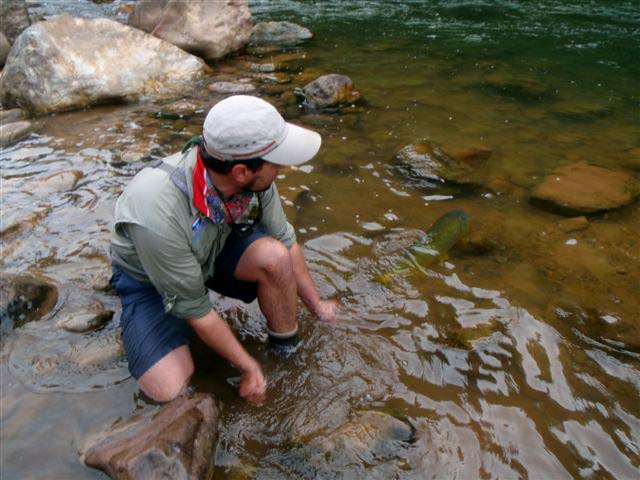
Ruhan Neethling
Just when you think you have maybe done it all, definitely heard it all, a revelation like this one from Ruhan Neethling comes along. Not to take anything away from Golden Dorado, though, a lot of the enticement this piece will conjure up for you comes from Ruhan’s expertise with a pen – and his patent love of fly fishing. Getting to know him over the last while in correspondence I can tell you that if he was in heaven on these Bolivian rivers, he’s also the sort of guy who would spend all day with a dry fly catching fish as long as your outspread hand from a stream he could straddle. And on some ice-locked, wind-blown mid-winter day on a lake in the Winterberg he’d probably be the last one off the water – and the first to light the fire back at the cottage. At least that’s how I read him. Whatever, his article is a lovely piece to have on my website.
Tom Sutcliffe


